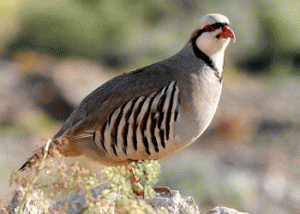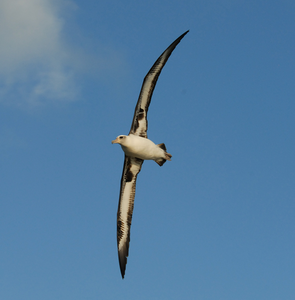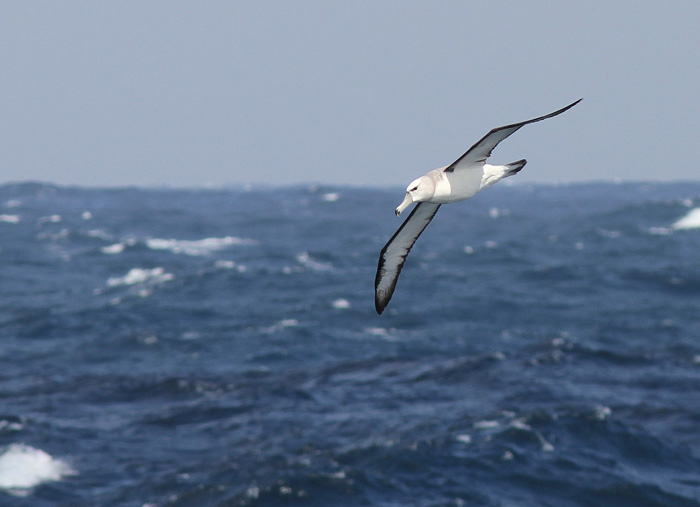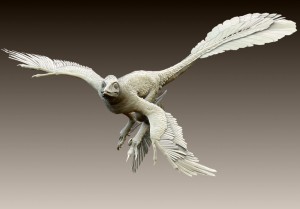November 24, 2012 at 1:04 am

Chukar Partridge
How is a half wing useful? This problem has divided the scientific community on the evolution of flight since the time of Darwin because it questions the evolutionary benefit of limbs that are incapable of flight. Bird ancestors clearly did not grow fully functional wings overnight and it is still unclear exactly how wings evolved. Read More »
By Galen Perry
|
Posted in Student post
|
Tagged chukar partridge, evolution, galliforme
|
November 24, 2012 at 12:15 am
It's a bird... It's a plane... It's Superman! Flying without the use of energy has always been seen a superpower that people have dreamed of. Such an ability has already been achieved by such birds as the Albatross and Petrel. By using the gust soaring, the Albatross can fly hundreds of miles without so much as flapping its wings. Although the idea of gliding with the wind is a relatively simple concept, researchers today are still puzzled by the amazing abilities of these birds.

An albatross soaring over the ocean
Read More »
By Austin
|
Posted in Student post
|
Tagged albatross, dynamic soaring
|
November 22, 2012 at 8:12 pm
The Cape Gannet seems like a normal bird, but like the peregrine falcon, this bird is able to change its body shape in order to hunt its prey. As the Cape Gannet takes a nose dive towards the water, this bird folds its wings behind its body so that it is able to be more aerodynamic when it enters the water.

Read More »
By Andrew Yoon
|
Posted in Student post
|
Tagged Aerodynamic, bird, Diving
|
November 22, 2012 at 12:57 am
 Dynamic soaring is the ability that allows albatrosses to travel great distances without constantly expending energy to flap their wings. Due to it, some birds are even able to fly around the entire Southern Ocean in only 46 days. However, this same evolutionary adaptation may restrict the range of environments that the various (endangered) species of albatross can inhabit. As albatrosses rely solely upon the wind to keep them aloft and propel their flight while seldom flapping their wings, they can live only in environments in which the average wind speed has the optimum magnitude for flight.
Dynamic soaring is the ability that allows albatrosses to travel great distances without constantly expending energy to flap their wings. Due to it, some birds are even able to fly around the entire Southern Ocean in only 46 days. However, this same evolutionary adaptation may restrict the range of environments that the various (endangered) species of albatross can inhabit. As albatrosses rely solely upon the wind to keep them aloft and propel their flight while seldom flapping their wings, they can live only in environments in which the average wind speed has the optimum magnitude for flight.
Read More »
By Yash Soni
|
Posted in Student post
|
Tagged albatross, birds, dynamic soaring
|
November 21, 2012 at 10:37 pm
The pygmy glider, most commonly known as the feather-tail glider, is also known as the flying mouse and its scientific name acrobates pygmaeus. It is the smallest mammalian glider of all. Pygmy gliders can be found in eastern Australia to southeast Australia. They tend to nest up high in trees. They chose their nest solely on the abundance of food.

Feather-tail Glider
The feather-tail’s fur tends to be mid-grey/brown with its underbelly being a lighter color; it has dark patches around its eyes and a white patch behind its large round ears. Head and body length of the feather-tail is 65-80mm, and its tail length is also between 70-80mm. Read More »
By Paulo
|
Posted in Student post
|
Tagged falling, flying squirrel, gliding, tail
|
November 21, 2012 at 8:33 pm
Science is full of controversies. Scientists are always debating over a variety of different topics. However, the characteristics of extinct animals is something that is fervently debated over. One of the main reasons that extinct animals are topics of debate is because no one can explicitly answer these questions and back it up with evidence because the animals are extinct. Although life size models can be created, these animals cannot be observed and studied live and therefore there cannot be any concrete evidence. This leads to many controversies, especially among dinosaurs. Read More »
By Catherine Chen
|
Posted in Student post
|
November 21, 2012 at 7:53 pm

Shy albatross. Credit: Steve Copsey (2012) "Three Amigo's Birding" blog.
The albatross is a bird that spends the majority of its life in the air over mainly the southern hemisphere’s oceans, landing only during breeding season on small islands. Albatrosses are capable of drinking salt water and live on average of fifty years in the wild, but their greatest feat is the ability to fly thousands of kilometers for up to forty-five days without landing. Until recently researchers have not had the necessary equipment to track albatrosses on small scale movement in order to better learn how they fly continuously for such an extreme distance and time.
Read More »
By nathanl
|
Posted in Student post
|
November 21, 2012 at 7:00 pm
Flight has always been a dream of mankind to attain. Sadly, we can’t flap wings and produce the amount of lift we need to achieve this kind of prolonged flight, but neither can most flying animals. A lot of animals that we think of as flying actually glide. We have figured out how to make flight work through gliding, as seen in early airplanes, and more specifically, hang gliders. Gliding all falls under one definition, but do us humans glide (by means of hang gliders) the same way that animals do?
Read More »
By Harris Gordon
|
Posted in Student post
|
Tagged drag, flying squirrel, gliding, hang glider, lift, manmade gliders, natural gliders
|
November 21, 2012 at 6:18 pm

Model of the Microraptor reconstructed from fossil evidence. Reconstructed by David Krentz
Ten years ago a pair of archaeologists dug up a remarkable dinosaur fossil in the Liaoning Province of northeastern China. It appeared to be very similar to other small raptors that had been found around the world. It had a feathered body, adding to the prominent theory that many raptors had feathers. The remarkable aspect of this dinosaur was that it seemed to have flight feathers on its hind legs as well as its upper limbs. This led Chinese paleontologist Xu Xing to hail it as a "four winged dinosaur" and he soon named it Microraptor gui.
Read More »
By samblack
|
Posted in Student post
|
Tagged dinosaurs, evolution, gliding, microraptor
|
November 21, 2012 at 1:15 pm
Fierce and majestic, the dinosaurs that walked this earth before us star in the dreams of many a child. Perhaps the most majestic of them all, the mighty pterosaur soared above the earth, king of the skies. Recent articles and reports from science writers have tried to burst this dream with the claim that the mighty pterosaur was simply too big to fly, but they may be making their reports too soon. “Science is messy” (Switek) and new papers and claims cannot be held up as scientific fact until they have been adequately supported by other scientists and meaningful evidence. The fact is that this drastic claim that the pterosaur could not fly has not yet reached this threshold of evidence to be considered scientific fact and therefore there is still hope for the pterosaur remaining the king of the skies.

Artist's impression of Quetzalcoatlus. Wikimedia Commons.
Read More »
By zach
|
Posted in Student post
|
Tagged able to fly, debate, flying, pterosaur, takeoff
|







